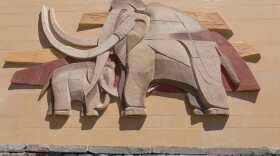The animals around us have long influenced our spiritual beliefs. For ancient Egyptians, the humble scarab beetle represented the passing of the sun across the sky, as well as the promise of redemption and rebirth.
In this week’s Exploradio, WKSU’s Jeff St.Clair looks at the mythology surrounding scarabs and meets a Cleveland researcher who has turned back the clock on their origins.
The basement of the Cleveland Museum of Natural History is a trove of random animal parts, crowned with dim cases filled with feathers, skulls, bits of bone, and stuffed specimens. It's also a working lab.

Rows of movable cabinets hold drawers containing thousands of neatly pinned insects ready for study.
It's where the invertebrate zoology collections manager, Nicole Gunter, is pouring over a case of squat beetles.
“Most people don’t realize how pretty dung beetles can be; we have metallic green, metallic blue, metallic reds.”
They are beautiful, both exotic and familiar, with hunched backs and powerful-looking legs sporting wavy combs. Gunter points to the distinctive club-shaped antennae that places them in the scarab family, "almost like a little reindeer horn.”
They're dung beetles, nature's clean-up crew.
Gunter is one of the world’s leading experts on dung-beetle evolution, and she’s clearly also one of a long line of scarab devotees.
“Dung beetles are fascinating. Over history there have been lots of different cultures that have used dung beetles as gods or deities.”
The scarab as god
More than 5,000 years ago, Egyptians found inspiration for a complex theology by watching scarab beetles roll balls of dung across the desert sand.

“For the Egyptians, that was symbolic of the sun moving across the sky,” says Gene Kritsky, author of "Insect Mythology" and a biology professor at Mount St. Joseph University in Cincinnati. Kritsky studied scarabs in Egypt as a Fulbright scholar.
He says the Egyptians believed the hardworking beetle labored to keep the cycle of days flowing for all of creation.
“This was a daily reminder of the importance of the sun god to the ancient Egyptians.”
Scarabs lay their eggs in buried dung balls and adults emerge fully formed from the ground, a symbol of life’s victory over death.
Over time, scarab amulets worked their way into all aspects of Egyptian life, they served as messengers for mercy in the afterlife and as everyday good luck charms.
“They’re like the Bic pen of ancient Egypt," says Kritsky, "they served important symbolic religious meaning, but also everyday utilitarian roles.”
A tasty addition to dinosaur dung
Back in Cleveland, Nicole Gunter has uncovered the even more ancient origins of the scarab beetle.

Using sophisticated DNA analysis, she found that dung beetles first appeared more than 100 million years ago. That was long before the large mammals they clean up after today appeared on the scene.
Gunter speculates that "of course the only other solution was dinosaurs” as producers of the requisite dung. But it wasn’t just any old dinosaur dung that gave rise to dung-eating beetles.
Gunter says something new was going into the front end of dinosaurs that made what came out the other end palatable for scarabs.
“This maps really, really well to what we know about angiosperm or flowering plant diversification. So this is the time period where they start to dominate the ecosystem.”
Dung beetles flourished with the rise of flowering plants, and after dinosaurs died out, they began cleaning up after mammals and have been going strong ever since.
Too much dung? No worries
Our story doesn’t end there. Gunter says Australians in particular owe a debt of gratitude to dung beetles. She says the by-products of widespread sheep and cattle ranching made life unbearable for people Down Under.
"There were so many flies around that you couldn’t really enjoy time outside in summer.” That is, until the government began importing European dung beetles to tidy up the mess.
From the sacred and spiritual, to the down and dirty, humans have had a unique relationship with dung beetles for more than 5,000 years.
Like the scarab pendants sown into mummy wrappings, the dung beetle holds a special place next to our hearts.
https://www.youtube.com/watch?v=Zskz-iZcVyY

















